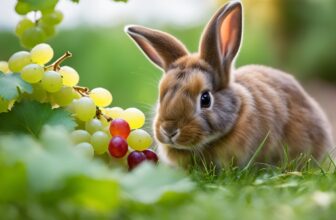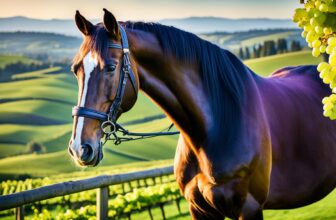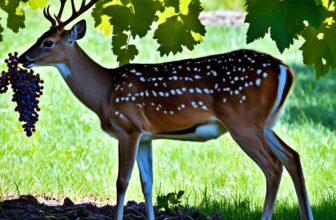Do Deer Eat Grapes? Wildlife Feeding Facts
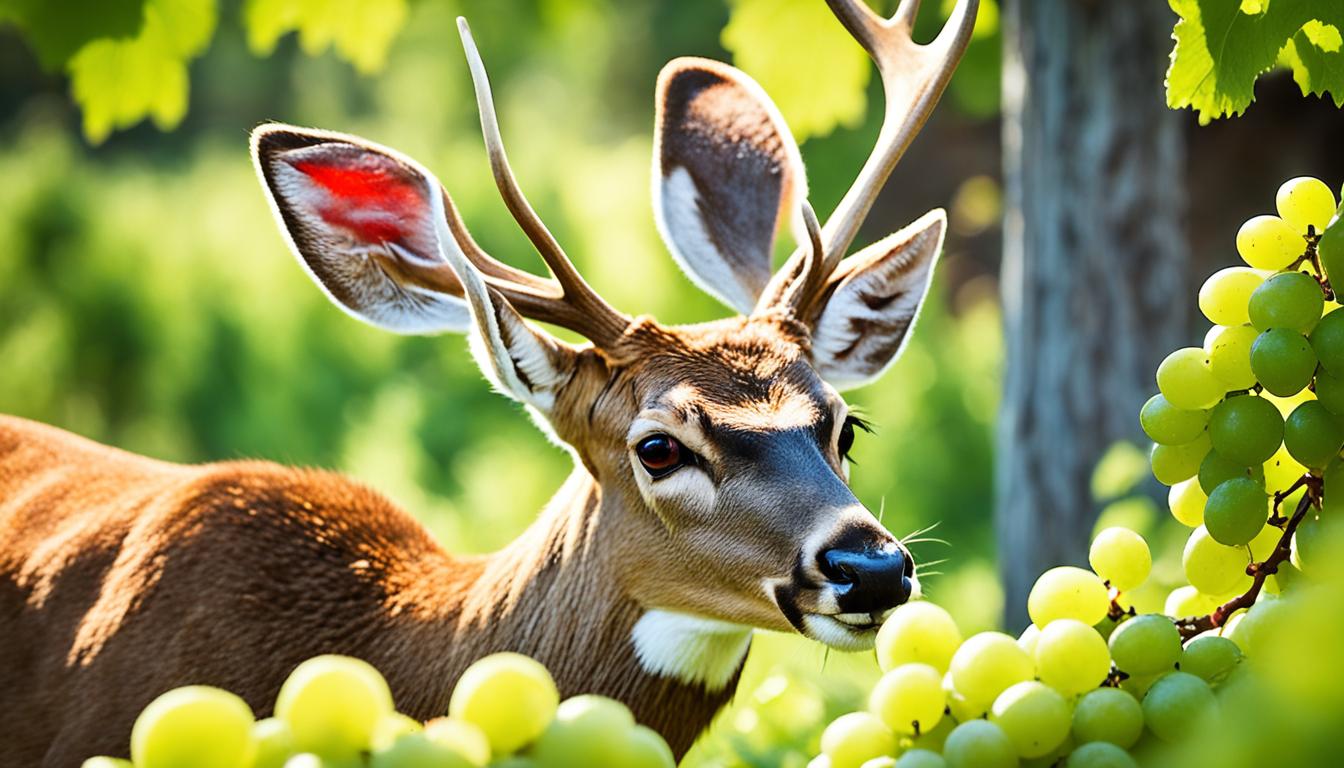
Are deer a menace to your grape vines and vineyard? You’re not alone. Deer have a notorious appetite for grapes and can cause significant damage to vineyards and backyard gardens. Understanding the dietary habits of these furry foragers is crucial for protecting your valuable grape crop. Join us as we explore the fascinating world of deer and their love for all things grape-related.
Key Takeaways
- Deer are known to feast on both grapes and grape vines, causing substantial damage to vineyards.
- Deer damage in vineyards can be identified by trampled plants, crushed fruits, and browsed branches with ragged, broken ends.
- Deer are likely the culprits if damages occur at a height of about 5 to 6 feet in a vineyard.
- Electric fencing is the preferred method for most growers to keep deer out of vineyards.
- Deer repellents can be effective in deterring deer from feeding on grapes, but a combination of tactics is often necessary.
Deer’s Love for Grapes and Grape Vines
White-tailed deer have a well-known affinity for grapes and grape vines. These herbivores will eagerly consume both the delectable fruits and the tender leaves of grape plants, often causing significant damage to vineyards. The telltale signs of deer activity in vineyards are easily recognizable, including trampled plants, crushed grapes, and ragged, broken ends of browsed branches.
Deer Damage in Vineyards
Deer’s relentless browsing can wreak havoc on grape plants, stunting their growth and diminishing their productivity. The most common form of deer damage in vineyards occurs at a height of around 5-6 feet, indicating the presence of white-tailed deer as the primary culprit. These agile animals can easily reach and feast on the tender shoots, leaves, and developing fruit, leaving vineyard owners to contend with the consequences of their voracious appetites.
The Height of Deer Damage in Vineyards
The distinctive height of deer damage in vineyards, typically between 5-6 feet, provides a clear indication of the primary wildlife responsible. White-tailed deer, with their impressive vertical reach, are the primary browsers capable of accessing and consuming the most vulnerable parts of grape plants, from the budding clusters to the succulent foliage.
Deer’s preference for grape plants and their ability to target specific heights within the vineyard canopy underscores the importance of implementing effective wildlife management strategies to protect these valuable agricultural crops.
Do Deer Eat Grapes?
Yes, deer have been observed to be enthusiastic about eating grapes and grape vines. Deer are particularly drawn to the young, tender shoots and freshly fertilized plants, making them a significant threat to newly established vineyards. This preference for grape plants can lead to substantial damage, as deer will strip the foliage and fruits, resulting in considerable losses for grape growers.
Deer’s Preference for Young Shoots and Fertilized Plants
Deer have been known to keep grape vines trimmed up to about six feet high, indicating their fondness for the young, succulent growth. Moreover, studies have shown that deer are attracted to areas where grape plants have been recently fertilized, as the nutrient-rich vegetation provides a tempting meal. Anecdotal evidence suggests that deer may prefer browsing on grape leaves during the summertime, further highlighting their affinity for grape-based resources.
The Impact of Deer on Vineyards
The impact of deer on vineyards can be substantial. Deer have been observed to come within 10 yards of human habitation to feast on grape vines, stripping them of leaves and fruits. This behavior can lead to significant losses for grape growers, as the damaged plants may struggle to produce a healthy crop. In some cases, individuals have resorted to hanging aluminum pie plates around grape vines in an attempt to deter deer, underscoring the extent of the problem.
Understanding the deer’s preference for grapes and the impact they can have on vineyards is crucial for developing effective wildlife management strategies. By recognizing the threat deer pose to grape production, grape growers can take proactive measures to protect their crops and mitigate the potential for substantial losses.
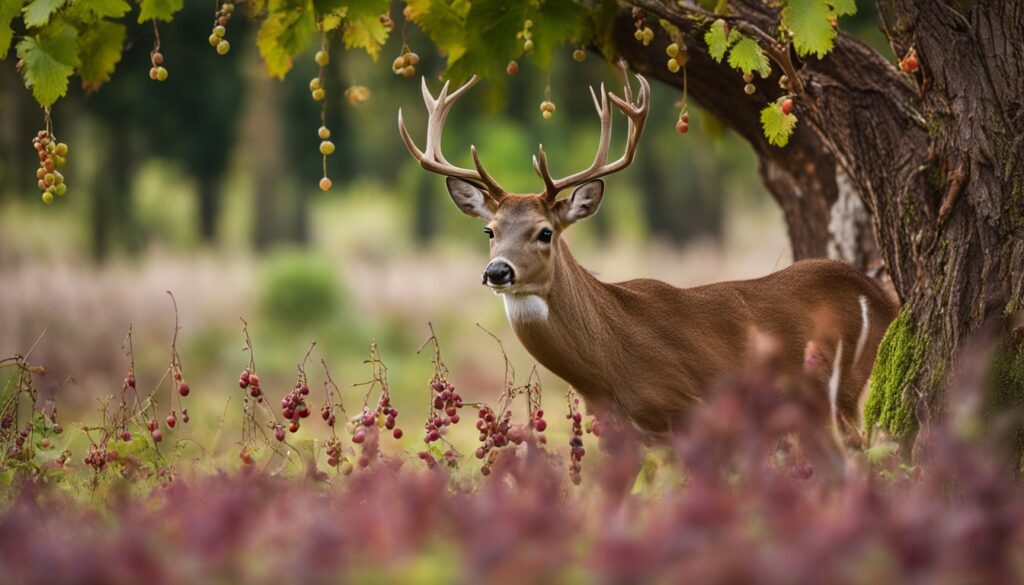
“Deer have been known to keep grape vines trimmed up to about six feet high, indicating their fondness for the young, succulent growth.”
Deterring Deer from Vineyards
Protecting vineyards from the ravages of deer is a critical challenge for growers. Deer are herbivores that feed primarily on vegetation, including leaves, twigs, fruits, nuts, and various plants. They are most active at dawn and dusk, making them a persistent threat to the delicate grapevines and valuable crop yields. Implementing effective deer deterrents is essential for maintaining the health and productivity of vineyards.
Installing an Electric Fence
One of the most effective methods for deterring deer from vineyards is the installation of an electric fence. These fences can effectively keep deer out without disrupting the natural aesthetics of the vineyard. According to Trident Enterprises, an eight-foot-tall, PVC-coated welded wire fence with two-inch by four-inch mesh openings is recommended for wildlife control in vineyards.
Traditional Fencing Options
In addition to electric fencing, traditional fencing solutions can also be employed to protect vineyards from deer. These options include wire mesh or tall fences, which can create a physical barrier to deter deer. However, these traditional fencing methods may be more expensive and visually intrusive compared to electric fences. Vineyard owners must carefully consider the pros and cons of each fencing option to find the best solution for their specific needs and location.
Incorporating sustainable and ethical practices in deer deterrents is also crucial for protecting the environment. Natural approaches, such as planting aromatic deterrents like marigolds, rosemary, and lavender, can create a repellent barrier around the vineyard without the use of harmful chemicals or excessive physical barriers.
Ultimately, a multi-faceted approach to deer deterrents for vineyards, including a combination of fencing, repellents, and landscaping techniques, can be the most effective way to safeguard valuable grape crops and ensure the long-term success of the vineyard.
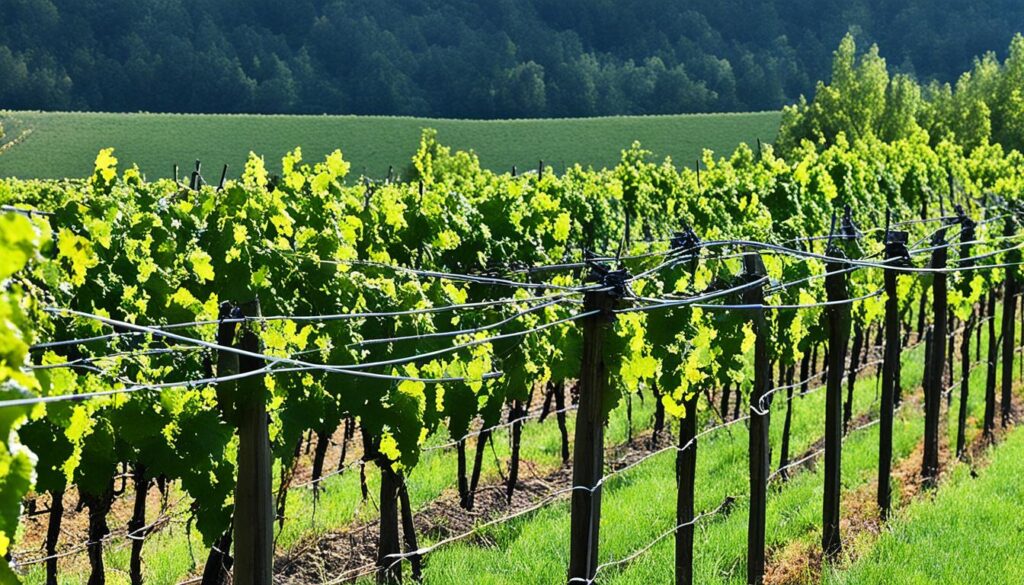
“In the Finger Lakes region, the most common pest problems impacting vineyards are deer, birds, and turkey, as reported by Matt Doyle of Doyle Vineyard Management in Hammondsport, New York.”
Using Deer Repellents
Deer repellents can be an effective complement to other deterrence methods when it comes to protecting vineyards and gardens from deer. These repellents work by making the plants taste or smell unpalatable to the deer. However, it’s crucial to utilize a variety of repellents and rotate them regularly to prevent deer from becoming accustomed to the scent or flavor.
Effectiveness of Repellents
While deer repellents may not completely stop deer from taking a few bites, they can help reduce the overall damage when used alongside other deterrence tactics, such as fencing or scare devices. The effectiveness of repellents can vary significantly based on factors like deer population density, location, and the specific product used.
Some studies have shown that repellents containing hot sauce or coyote urine can be up to 80% effective in deterring deer, while other natural options like chicken eggs or habanero peppers can also provide moderate protection. Proper application and reapplication of these repellents is crucial for maintaining their effectiveness.
Incorporating a combination of physical barriers, such as fencing, and chemical repellents can create a multi-layered approach to protecting grape plants and other valuable crops from deer damage.
“Deer Off®” repellents are reported to last up to 90 days with a single application, making them a convenient option for long-term grape plant protection.
Ultimately, the choice and effectiveness of deer repellents will depend on the specific needs and challenges of the vineyard or garden. By understanding the various options and their relative efficacy, grape growers and gardeners can make informed decisions to safeguard their prized plants from the unwanted attention of deer.
Feeding Facts: Deer and Raisins
While deer are known for their love of fresh grapes, they also find raisins, the dried version of grapes, to be an equally enticing treat. Raisins provide deer with a sweet and energy-rich snack, and their scent and taste often draw the attention of these curious herbivores.
Deer’s Love for Raisins
Wild raisins, also known as Viburnum cassinoides, are commonly eaten by deer during the winter months when other food sources may be scarce. Deer are attracted to the high sugar content in raisins, which can make up over 72% of their composition. However, this same high sugar level can also be potentially toxic to deer, as their digestive system changes with the seasons.
Raisins have been successfully used to attract deer in some areas, as their sweet aroma and taste can be irresistible to these animals. Feeding deer raisins, however, might be frowned upon in many parts of the U.S. based on local laws and regulations.
Nutritional Comparison: Grapes vs. Raisins
While both grapes and raisins can be enjoyed by deer, it’s important to understand the nutritional differences between the two. Grapes are a natural and wholesome food source for deer, providing them with essential nutrients and vitamins. In contrast, raisins have a much higher sugar content, which can be detrimental to the deer’s health, especially during the winter months when their digestive system is adapted to consuming more fibrous plant material.
When it comes to feeding deer, it’s crucial to do so in moderation and with a focus on providing a balanced and healthy diet. Deer should be fed at dawn and dusk, the times when they typically browse, and their diet should include water to assist in digesting harder foods.
While raisins can be a tempting snack for deer, it’s important to remember that their dietary needs are complex and vary with the season. By understanding the nutritional differences between grapes and raisins, and by following local laws and regulations, we can ensure that deer receive the proper care and sustenance they require.
Other Dried Fruits and Berries Deer Enjoy
While deer are often associated with a fondness for grapes and raisins, their dietary preferences extend far beyond these familiar foods. Deer have a natural inclination towards a variety of dried fruits and berries, showcasing their adaptability and diverse nutritional needs.
From dehydrated cranberries and currants to dried apricots, deer seem to have a particular affinity for sweet and energy-dense plant-based foods. This should be considered when designing wildlife-friendly landscaping or managing deer populations in areas where they may come into contact with human-cultivated crops and gardens.
Deer’s deer feeding habits reveal a keen interest in a wide range of dried fruits and berries. These nutrient-rich foods not only provide essential calories but also offer valuable vitamins, minerals, and antioxidants that support the deer’s overall health and well-being.
Understanding the deer diet and their preferences for various dried fruits and berries can help land managers, gardeners, and wildlife enthusiasts create more effective wildlife-friendly strategies and minimize potential conflicts between deer and human activities.
| Dried Fruit/Berry | Nutritional Benefits for Deer |
|---|---|
| Cranberries | High in antioxidants, vitamins C and E, and fiber |
| Currants | Rich in vitamins A and C, as well as minerals like iron and potassium |
| Apricots | Packed with vitamins A and C, and a good source of potassium |
| Blueberries | High in antioxidants and provide essential nutrients like vitamin C and manganese |
| Blackberries | Rich in fiber, vitamins C and K, and important minerals like magnesium and calcium |
By incorporating these deer-friendly dried fruits and berries into landscaping designs or wildlife management strategies, land owners and managers can create more wildlife-friendly environments that cater to the diverse nutritional needs of deer and other local wildlife species.
“Deer have a remarkable ability to adapt their diet to the available food sources in their environment, showcasing their versatility and resilience as a species.”
Conclusion
Deer’s love for grapes and grape vines can pose a significant challenge for grape growers and gardeners. Understanding the deer’s feeding habits and preferences, as well as implementing effective deterrence methods, is crucial for protecting vineyards and gardens from potential damage. A combination of physical barriers, such as electric or traditional fencing, and the strategic use of deer repellents can help deter deer and minimize their impact on valuable crops and plants.
By adopting a comprehensive wildlife management approach, grape growers and gardeners can find ways to coexist with deer and maintain the health and productivity of their vineyards and gardens. This includes incorporating deer-resistant plants, creating wildlife-friendly landscaping, and educating the community on the importance of deer management in vineyards.
Ultimately, the key to managing deer interactions with grapes lies in a multifaceted strategy that balances the needs of both the growers and the deer. Through a collaborative effort between grape growers, wildlife experts, and local communities, the delicate balance between deer and grape cultivation can be maintained, ensuring the sustainability of the grape industry and the preservation of the natural ecosystem.



